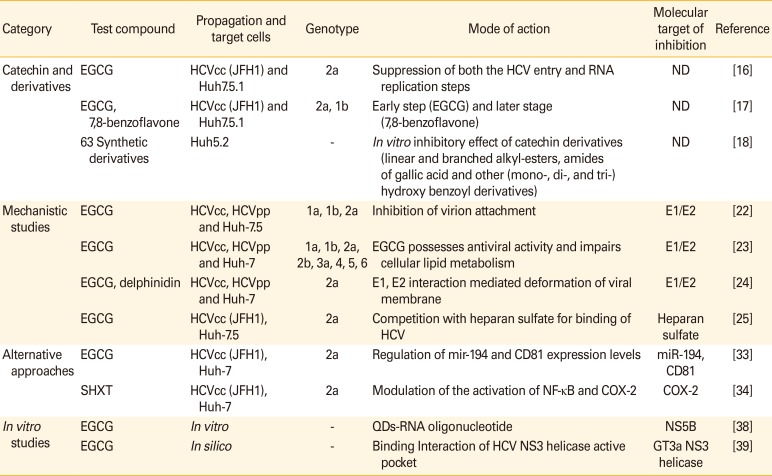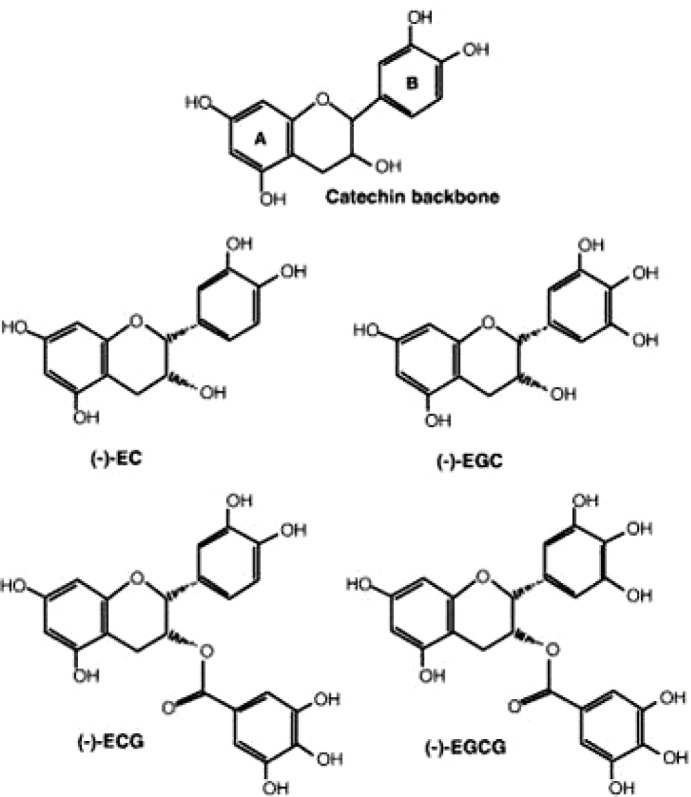1. Cao J, Han J, Xiao H, Qiao J, Han M. Effect of tea polyphenol compounds on anticancer drugs in terms of anti-tumor activity, toxicology, and pharmacokinetics. Nutrients. 2016; 8:E762. PMID:
27983622.

2. Nakayama M, Suzuki K, Toda M, Okubo S, Hara Y, Shimamura T. Inhibition of the infectivity of influenza virus by tea polyphenols. Antiviral Res. 1993; 21:289–299. PMID:
8215301.

3. Kim M, Kim SY, Lee HW, et al. Inhibition of influenza virus internalization by (−)-epigallocatechin-3-gallate. Antiviral Res. 2013; 100:460–472. PMID:
23954192.

4. Song JM, Lee KH, Seong BL. Antiviral effect of catechins in green tea on influenza virus. Antiviral Res. 2005; 68:66–66. PMID:
16137775.

5. Yamaguchi K, Honda M, Ikigai H, Hara Y, Shimamura T. Inhibitory effects of (−)-epigallocatechin gallate on the life cycle of human immunodeficiency virus type 1 (HIV-1). Antiviral Res. 2002; 53:19–34. PMID:
11684313.

6. Fassina G, Buffa A, Benelli R, Varnier OE, Noonan DM, Albini A. Polyphenolic antioxidant (−)-epigallocatechin-3-gallate from green tea as a candidate anti-HIV agent. AIDS. 2002; 16:939–941. PMID:
11919502.

7. Williamson MP, McCormick TG, Nance CL, Shearer WT. Epigallocatechin gallate, the main polyphenol in green tea, binds to the T-cell receptor, CD4: potential for HIV-1 therapy. J Allergy Clin Immunol. 2006; 118:1369–1374. PMID:
17157668.

8. Weber C, Sliva K, von Rhein C, Kummerer BM, Schnierle BS. The green tea catechin, epigallocatechin gallate inhibits chikungunya virus infection. Antiviral Res. 2015; 113:1–3. PMID:
25446334.

9. Lyu SY, Rhim JY, Park WB. Antiherpetic activities of flavonoids against herpes simplex virus type 1 (HSV-1) and type 2 (HSV-2) in vitro. Arch Pharm Res. 2005; 28:1293–1301. PMID:
16350858.
10. Isaacs CE, Wen GY, Xu W, et al. Epigallocatechin gallate inactivates clinical isolates of herpes simplex virus. Antimicrob Agents Chemother. 2008; 52:962–970. PMID:
18195068.

11. Isaacs CE, Xu W, Merz G, Hillier S, Rohan L, Wen GY. Digallate dimers of (−)-epigallocatechin gallate inactivate herpes simplex virus. Antimicrob Agents Chemother. 2011; 55:5646–5653. PMID:
21947401.

12. Shepard CW, Finelli L, Alter MJ. Global epidemiology of hepatitis C virus infection. Lancet Infect Dis. 2005; 5:558–558. PMID:
16122679.

13. Kenny-Walsh E. The natural history of hepatitis C virus infection. Clin Liver Dis. 2001; 5:969–977. PMID:
11685804.

14. Alter MJ. Epidemiology of hepatitis C. Hepatology. 1997; 26(3 Suppl 1):62S–65S. PMID:
9305666.

15. Manns MP, Wedemeyer H, Cornberg M. Treating viral hepatitis C: efficacy, side effects, and complications. Gut. 2006; 55:1350–1359. PMID:
16905701.

16. Chen C, Qiu H, Gong J, et al. (−)-Epigallocatechin-3-gallate inhibits the replication cycle of hepatitis C virus. Arch Virol. 2012; 157:1301–1312. PMID:
22491814.

17. Fukazawa H, Suzuki T, Wakita T, Murakami Y. A cell-based, microplate colorimetric screen identifies 7,8-benzoflavone and green tea gallate catechins as inhibitors of the hepatitis C virus. Biol Pharm Bull. 2012; 35:1320–1327. PMID:
22863932.

18. Rivero-Buceta E, Carrero P, Doyaguez EG, et al. Linear and branched alkyl-esters and amides of gallic acid and other (mono-, di- and tri-) hydroxy benzoyl derivatives as promising anti-HCV inhibitors. Eur J Med Chem. 2015; 92:656–671. PMID:
25617695.

19. Xu J, Wang J, Deng F, Hu Z, Wang H. Green tea extract and its major component epigallocatechin gallate inhibits hepatitis B virus in vitro. Antiviral Res. 2008; 78:242–249. PMID:
18313149.

20. Ye P, Zhang S, Zhao L, et al. Tea polyphenols exerts antihepatitis B virus effects in a stably HBV-transfected cell line. J Huazhong Univ Sci Technolog Med Sci. 2009; 29:169–169. PMID:
19399398.

21. He W, Li LX, Liao QJ, Liu CL, Chen XL. Epigallocatechin gallate inhibits HBV DNA synthesis in a viral replicationinducible cell line. World J Gastroenterol. 2011; 17:1507–1514. PMID:
21472112.
22. Ciesek S, von Hahn T, Colpitts CC, et al. The green tea polyphenol, epigallocatechin-3-gallate, inhibits hepatitis C virus entry. Hepatology. 2011; 54:1947–1955. PMID:
21837753.

23. Calland N, Albecka A, Belouzard S, et al. (−)-Epigallocatechin-3-gallate is a new inhibitor of hepatitis C virus entry. Hepatology. 2012; 55:720–729. PMID:
22105803.

24. Calland N, Sahuc ME, Belouzard S, et al. Polyphenols inhibit hepatitis C virus entry by a new mechanism of action. J Virol. 2015; 89:10053–10063. PMID:
26202241.

25. Colpitts CC, Schang LM. A small molecule inhibits virion attachment to heparan sulfate- or sialic acid-containing glycans. J Virol. 2014; 88:7806–7817. PMID:
24789779.

26. Wang Y, Li J, Wang X, et al. (−)-Epigallocatechin-3-gallate enhances hepatitis C virus double-stranded RNA intermediates-triggered innate immune responses in hepatocytes. Sci Rep. 2016; 6:21595. PMID:
26879672.

27. Wong J, Zhang J, Si X, et al. Autophagosome supports coxsackievirus B3 replication in host cells. J Virol. 2008; 82:9143–9143. PMID:
18596087.

28. Li J, Liu Y, Wang Z, et al. Subversion of cellular autophagy machinery by hepatitis B virus for viral envelopment. J Virol. 2011; 85:6319–6333. PMID:
21507968.

29. Sir D, Kuo CF, Tian Y, et al. Replication of hepatitis C virus RNA on autophagosomal membranes. J Biol Chem. 2012; 287:18036–18043. PMID:
22496373.

30. Tanida I. Autophagy basics. Microbiol Immunol. 2011; 55:1–11. PMID:
21175768.

31. Zhong L, Hu J, Shu W, Gao B, Xiong S. Epigallocatechin-3-gallate opposes HBV-induced incomplete autophagy by enhancing lysosomal acidification, which is unfavorable for HBV replication. Cell Death Dis. 2015; 6:e1770. PMID:
25996297.

32. Liao PC, Ng LT, Lin LT, Richardson CD, Wang GH, Lin CC. Resveratrol arrests cell cycle and induces apoptosis in human hepatocellular carcinoma Huh-7 cells. J Med Food. 2010; 13:1415–1423. PMID:
20946021.

33. Mekky RY, El-Ekiaby NM, Hamza MT, et al. Mir-194 is a hepatocyte gate keeper hindering HCV entry through targeting CD81 receptor. J Infect. 2015; 70:78–87. PMID:
25218426.

34. Lee JC, Tseng CK, Wu SF, Chang FR, Chiu CC, Wu YC. San-Huang-Xie-Xin-Tang extract suppresses hepatitis C virus replication and virus-induced cyclooxygenase-2 expression. J Viral Hepat. 2011; 18:e315–e324. PMID:
21692943.

35. Lu L, Wei L, Peng G, et al. NS3 protein of hepatitis C virus regulates cyclooxygenase-2 expression through multiple signaling pathways. Virology. 2008; 371:61–70. PMID:
17964630.

36. Nunez O, Fernandez-Martinez A, Majano PL, et al. Increased intrahepatic cyclooxygenase 2, matrix metalloproteinase 2, and matrix metalloproteinase 9 expression is associated with progressive liver disease in chronic hepatitis C virus infection: role of viral core and NS5A proteins. Gut. 2004; 53:1665–1672. PMID:
15479690.

37. Giannitrapani L, Ingrao S, Soresi M, et al. Cyclooxygenase-2 expression in chronic liver diseases and hepatocellular carcinoma: an immunohistochemical study. Ann N Y Acad Sci. 2009; 1155:293–299. PMID:
19250220.
38. Roh C, Jo SK. (−)-Epigallocatechin gallate inhibits hepatitis C virus (HCV) viral protein NS5B. Talanta. 2011; 85:2639–2639. PMID:
21962695.

39. Fatima K, Mathew S, Suhail M, et al. Docking studies of Pakistani HCV NS3 helicase: a possible antiviral drug target. PLoS One. 2014; 9:e106339. PMID:
25188400.

40. Huang HC, Chen CC, Chang WC, Tao MH, Huang C. Entry of hepatitis B virus into immortalized human primary hepatocytes by clathrin-dependent endocytosis. J Virol. 2012; 86:9443–9453. PMID:
22740403.

41. Huang HC, Tao MH, Hung TM, Chen JC, Lin ZJ, Huang C. (−)-Epigallocatechin-3-gallate inhibits entry of hepatitis B virus into hepatocytes. Antiviral Res. 2014; 111:100–111. PMID:
25260897.






 PDF
PDF ePub
ePub Citation
Citation Print
Print




 XML Download
XML Download